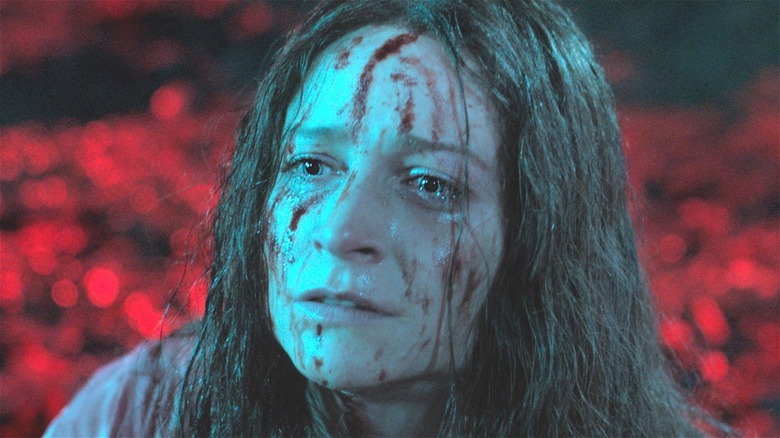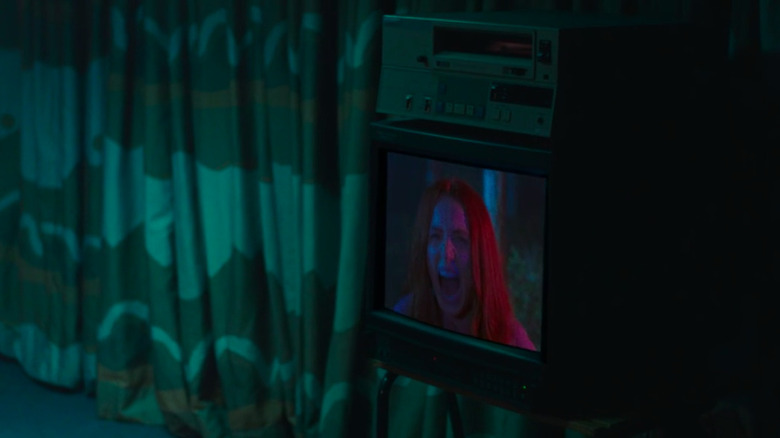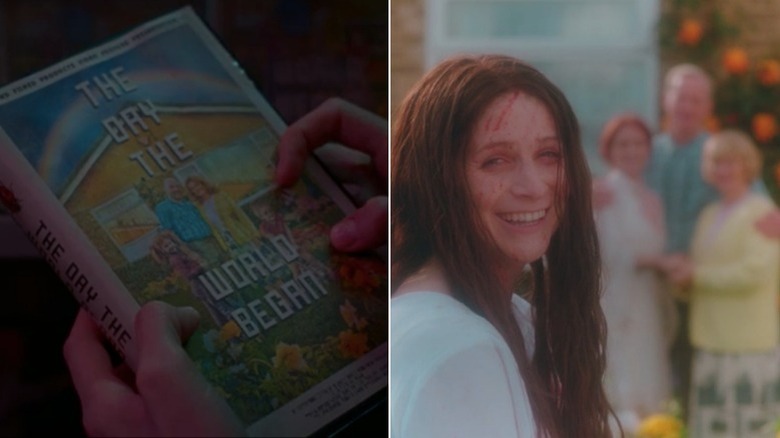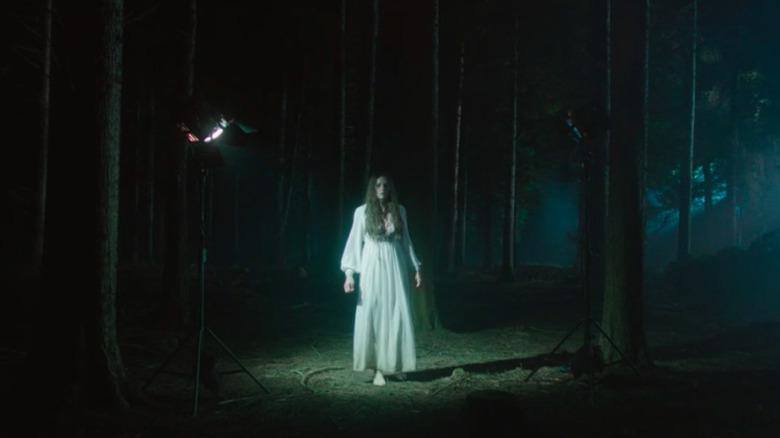The Ending Of Censor Explained
The debate over whether or not violent video games and movies impact crime rates has been ongoing for decades, with seemingly no end in sight. During the 1980s, a wave of rising crime rates coincided with the distribution of graphic low-budget horror and exploitation movies in the U.K. This led to a pearl-clutching media frenzy and sparked a national conversation about censorship.
News outlets, religious organizations, commentators and activists blamed the violent films for high crime rates and other social decay. Crusading for the protection of children, they aimed to rate and ban these films. Dubbed "video nasties" by the National Viewers' and Listeners' Association, an advocacy group that ceased media they found harmful or offensive, the spread of these films led to headlines like "How High Street Horror is Invading the Home" and "Sadism for Six Year Olds."
Exploring that moral panic, director Prano Bailey-Bond's debut feature film "Censor" follows Enid Baines (Niamh Algar), a film censor who becomes increasingly disturbed as she convinces herself that her missing sister, Nina, is the star of these splatter films, Alice Lee (Sophia La Porta). The film ends with a desperate Enid showing up on set to "rescue" Alice, killing anyone who gets in her way. Reality is blurred as Enid believes she has redeemed herself by saving Nina and taking her to their parents, but the glitches in that daydream reveal Alice's terror. The rainbow skies and the picture-perfect, ethereal ending aren't what they seem.
So, what happened at the end of "Censor"?
Video nasties vs. real-life violence
As the film's title suggests, "Censor" heavily references the era of video nasties. Mirroring reality, politicians, reporters, and members of the public sought to blame the films for the rise in violent crimes. In the opening montage, graphic clips from various video nasties play as broadcasters heighten public fears by connecting the dots between criminal activity and this niche media.
In an interview with Cineuropa, Bailey-Bond discussed her affinity for the video nasty era, asking herself, "If violent films are supposed to drive a person to commit violent acts, what protects the censor from losing control?" Consuming hours and hours of the most brutal, gruesome films, Enid is focused and strict about "protecting" the public. As her obsession with Alice grows, though, she loses sight of her goal and morphs into the very person she fears.
So, what made this unstable censor lose control? "Don't Go in the Church," a film about sisterly betrayal, strikes a nerve for Enid. This viewing brings forth years of emotional turmoil over her presumed dead sister. Her need for closure, coupled with the visual similarities between Alice and a police sketch of Nina, drives her to act out.
Coming full-circle, the end of the film includes a radio broadcaster within Enid's fantasy announcing the eradication of video nasties, which drops the crime rate to zero and boosts employment rates. The public is gleefully informed that "there's nothing to be afraid of anymore!" Enid, who bought into the misguided conservative fears, is unable to register that she has done anything wrong. While it isn't shown in the film, it's clear that the public would go on to blame her consumption of morally corrupt films for her crimes without factoring in her mental instability.
Haunted by her hazy memories
Enid's bloody breakdown is the culmination of her guilt over being the last person to see her little sister alive. She struggles to cope with Nina's disappearance and obsesses over finding an answer for what happened. Throughout the film, she has flashbacks of that day in the forest, but they're often conflated with the films she watches for work. Other dreams and flashbacks include her parents begging to know what happened as she looks away and cries.
Unable to help, Enid grasps at straws to find closure. Her last-ditch attempt to convince her parents that Nina is alive frustrates them. "We've been here before, Enid," her father chides. "Every time, it's not her."
This exchange suggests that she's come up with outlandish ideas before. At one point in the film, her mother tries to comfort her by saying, "You can't be responsible for everyone, Enid." This time, however, her attempt to absolve the guilt takes a deadly turn. Enid's on-set killing spree and the abduction of Alice reflect her deteriorating mental state, while the dreamlike state she enters during the finale shows her desperation to right things with her family at any cost.
Or... did Enid kill Nina?
It's also possible that Enid's psychotic break isn't just because she can't accept her sister's death. "Censor" teases the idea that Nina's disappearance was at the hands of Enid. Many of her flashbacks to that day include her parents begging to know what happened, but one nightmare includes a major jump scare where her mom screams, "It's all your fault!"
Enid is also shown in that dream state clutching a bundle of Nina's bright red hair with a note reading "Don't Go in the Church," referencing the video nasty in which an older sister slaughters her little sister in the woods. Maybe what happened that day was an accident; that would explain her dedication to her censorship job.
The Amnesia Killer, a man who is allegedly inspired by a film Enid rated, could be a stand-in for her crimes. Like the killer, perhaps she blocks out what she did to Nina, and her inability to recall what happened is assumed to be a trauma response. After watching "Don't Go in the Church," Enid's usual composure wavers as she panics and gets sick.
She then asks her coworker how the Amnesia Killer could just "forget" that he slaughtered his family. "People construct stories to cope," says the coworker. "You'd be surprised what the human brain can edit out when it can't handle the truth."
Between this and a line that follows Enid throughout the film, "The evil is contagious," it's possible that she bears more responsibility for Nina's fate than anyone realized. Of course, the only one who knows the truth is Enid, and as the ending proves, she's not exactly a reliable source when it comes to reality.



